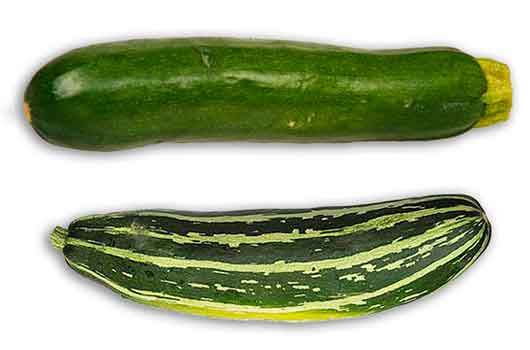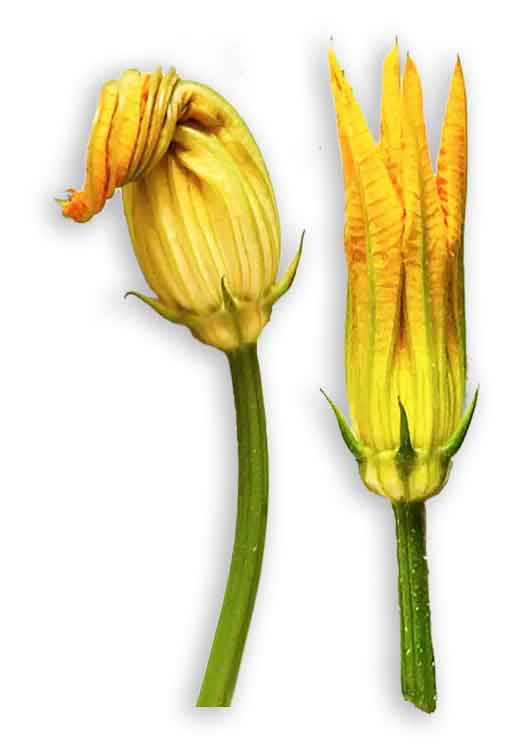 Gen info Gen info
- The zucchini group has a strong affinity with the vegetable marrow. Its origin is recent (19th century). The plants are generally semi-shrubby and the cylindrical fruit does not broaden or broadens only slightly.
- Zucchini is a relatively new cultivar-group of C. pepo. Its first known evidence of existence was reported in a book on horticulture published in Milan in 1901. (13)
- Zucchini (C. pepo L. var cylindrica Paris) is the most commonly cultivated group of cultivars at present.
- Taxonomically, the morphotypes "pumpkin", "vegetable marrow", "cocozelle", and "zucchini" are subspecies pepo. (12)
- Of the summer squash, the zucchini (C. pepo subsp. pepo Zucchini group) is by far the most cosmopolitan. (13)
- Zucchini comes in many varieties; a few of the popular ones are: (1) Aristocrat: waxy skin, medium green, (2) Gold rush: fruit is golden, (3) Black zucchini: most common variety, skin is dark green, white fleshed, and (4) Zucchini Gadzukes: green fruit with distinct light green ridges, (5) Ronde de Nice: which is round, (6) Grisette de Provence. which is gray, (7) Diamond, (8) Black beauty.
(•)
 Botany Botany
Cucurbita pepo is an annual, monoecious climber. Stems are fleshy, stout, setose, with a series of multifid tendrils. Leaves are simple. Petiole is stout, fleshy, setose, up to 10 cm long. Blade is triangular, 20-30 cm across, irregularly five-lobed, setose, cordate at the base, dentate at base and acute at apex. Flowers are massive and solitary on a 2-20 cm long, setose pedicel. Corolla is orangish, membrana-ceous, infundibuliform and five-lobed, growing up to 10 cm long. In male flowers, calyx is campanulate with five linear segments which are 1-2.5 cm long. Androecium includes 3 stamens with 1.5 cm long filaments. Female flowers have a reduced calyx and an ovary which is ovoid and unilocular. Fruiting pedicel is robust and pentagonal. Fruit is a berry in a multitude of shapes and colors according to varieties. Seeds are ovoid, flattened, 1-1.5 x 0.5-1 cm, white and smooth.
Distribution
- Cultivated worldwide for its edible fruit.
 Constituents Constituents
- Nutritional analysis of raw summer squash, cup, sliced; 113g: (Proximates} water 106.94 g, energy 18Kcal or 78 kj, protein 1.37 g, total fat (lipid) 0.2 g, ash 0.7 g, carbohydrate 3.79 g, total dietary fiber 1.2 g, total sugars 2.49 g, sucrose 0.03 g, glucose 0.85 g, fructose 1.07 g; (Minerals) calcium 17 mg, iron 0.4 mg, magnesium 19 mg, phosphorus 43 mg, potassium 296 mg, sodium 2 mg, zinc 0.33 mg, copper 0.058 mg, manganese 0.198 mg, selenium 0.2µg; (Vitamins: water soluble) B1/thiamin 0.054 mg, B2/riboflavin 0.16 mg,B3/niacin 0.55 mg, B5/pantothenic acid 0.175 mg, B6/pyridoxine 0.246 mg, B9/folate 33µg, choline 7.6 mg, vitamin C 19.2 mg; (Vitamins: fat soluble) Vitamin A 11µg or 226 IUU, beta carotene 136 µg, lutein+zeaxanthin 2401 µg. vitamin E/alpha tocopherol 0.14 mg, K/phylloquinone 3.4 µg; (Lipids) total saturated fatty acids 0.05g, total monosaturated fatty acids 0.018 g; (Amino acids) tryptophan, threonine, isoleucine, leucine, lysine, methionine, cystine, phenylalanine, tyrosine, valine, arginine, histidine, alanine, aspartic acid, glutamic acid, glycine, proline, serine in range of 0.012 - 0.163 g. (USDA Nutrient database)
- GC-MS study of vegetable marrows leaves, yellow zucchini leaves, and green zucchini leaves yielded 14 fatty acids, of which 13 were identified. Palmitic acid was dominant among saturated fatty acids and linoleic acid among unsaturated fatty acids. Linoleic acid was 33,25%, 33.77%, and 32.50% in vegetable marrow, yellow, and green zucchini leaves, respectively, (18)
Properties
- Considered laxative, astringent, anti-inflammatory.
-
Studies have suggested antioxidant, antigenotoxic, apoptotic, cytotoxic, anti-ulcer, antimicrobial properties.
Parts used
Fruit, leaves, flowers.
Uses
Edibility
- Skin, flesh, and seeds are edible.
-
Eaten as vegetable in the unripe state.
- Pickled when very immature.
Folkloric
- No reported folkloric medicinal use in the Philippines.
- Seeds chewed for bladder problems.
- Juice drunk to relieve constipation.
- Crushed seeds used for deworming.
Others
- Cosmetic: Zucchini peels placed around the eyes to reduce swelling and puffiness.
 Studies Studies
• Antiulcer / Aspirin-Induced Gastric and Duodenal Ulcers / Fruit: Aspirin-induced gastric and duodenal ulcers was associated with a significant decrease in alkaline phosphatase activity and mucosal thickness and increase in ulcer index in albino rats/ Pretreatment with zucchini fruit pulp extract showed gastroduodenal protective and anti-ulcerogenic properties. (4)
• Modulation of Degenerative Processes / Genotoxicity, Cytotoxicity and Apoptotic Effects: Study selected and evaluated four distinctive bioactive components: lutein, ß-carotene, zeaxanthin and dehydroascorbuc acid, Results showed all the substances were non-genotoxic and all were anti-genotoxic except the highest concentration of lutein. Yellow zucchini epicarp and mesocarp exhibited highest cytotoxic activity . Light green zucchini skin induced internucleosomal DNA fragmentation, ß-carotene molecule possible responsible for its pro-apoptotic activity. Study suggests the fruit plays a positive role in human health and nutrition the components are safe, and able to significantly inhibit H2O2-induced damage and exhibit antiproliferative and pro-apoptotic activities toward HL-60 (human promyelocytic leukemia cells). (5)
• Antioxidative Property: Study evaluated the antioxidative properties zucchini (Cucurbita pepo) and bitter gourd *M charantia). Zucchini showed an average total phenolic compounds of 8.67 GAE/g fresh weight. It was 12.19% as effective as ascorbic acid in inhibiting free radical DPPH. Zucchini recorded significantly higher SOD activities than bitter gourd. Bitter gourd showed significantly higher antioxidant content and ß-glucosidase activities. (6)
• Effect on Biologic Indicators for Prevention of Cardiovascular Disease: Study evaluated the effects of fresh zucchini on nutritional status and biological indicators for the prevention of cardiovascular disease in Sprague-Dawley rats fed high-fat diets. Strongest effects were seen with regular consumption of zucchini. In the Beta-carotene Cancer Prevention study, there was a protective effect of zucchini intake on CHD mortality. Lipid reducing effects were attributed to its fibers, which reduce plasma LDL by inhibiting the absorption of cholesterol and bile acids and improvement of activity of LDL receptors. In the rat model, the zucchini fruit can reduce risk for cardiovascular disease. reduce the serum lipid profile *TC, TG, LDL and VLDL) ans increase HDL-C. Effects are enhanced by its antioxidant properties. (7)
• Microbial Load Reduction: Freezing vegetables requires pre-treatments to reduce microbial load and destroy enzymes that impair frozen product quality. Study evaluated alternatives to blanching treatments, using UV-C radiation combined with milder thermal treatments or with thermosonication, to improve the quality of the final frozen vegetable. Zucchini, the vegetable under study, often frozen throughout the year, was inoculated with two vegetable contaminants, Enterococcus faecalis ad Deinococcus radiodurans cells. Best results showed to be a combination of water blanching at temperatures as low as 85ºC at <2min with 25 pulses of UV-C or thermosonification at 90ºC also combined with UV-C pulses, both resulting in 3 log reductions of both microorganisms under study, hence minimizing quality changes of frozen zucchini. (8)
• Antioxidant Properties / Flowers: Total antioxidant capacities were determined in extracts of C. pepo L. female and male flowers. DPPH, HO-scavenging capacities and total phenolic values of female and male were higher in aqueous ethyl acetate than in other extracts. All determined antioxidant capacities of female were significantly higher than male. (9)
• Latex-Fruit Syndrome: There have been reports of cross-reactivity between latex, fruits, and vegetables. Blanco et al. suggested the designation latex-fruit syndrome. Study reports on a female patient with significant exposure to rubber and multiple episodes of anaphylaxis. She also reported episodes after ingestion of various fruits, i.e. almond nut, hazelnut, banana, kiwi, mango, avocado, fig, tomato, turnip, and zucchni. Skin prick tests positivity included zucchini with 7 mm wheal with latex 12 mm. Serum IgE to zucchini was <0.35KU/l. Cross-reactivity between zucchini and latex had been previously described. Study suggested inclusion of zucchini to the long list of plant-derived foods cross-reactive to latex and sensitization to these vegetables must be assessed in patients with latex anaphylaxis. (10)
• Fatty Acid Composition / Leaves: Study evaluated the qualitative and quantitative content of fatty acids in leaves of vegetable marrows (C. pepo L. var. giromontina Alef.), zucchini (C. pepo L. var. cylindrica Paris) yellow- and green-fruits varieties using GC-MS. Fourteen fatty acids were identified. Unsaturated fatty acids were dominant in the raw plant material. Total content of unsaturated fatty acids was 60.74% in vegetable marrow leaves, 64.35% yellow zucchini leaves and 68.85% green zucchini leaves, among which linoleic and linolenic acid were dominant. Data for atherogenic and thrombogenic indices, as well as fatty acid composition of investigated raw material indicated the potential of its wide use for the design of functional products, including baby food products with directed anti-atherogenic and hypolipidemic properties. (14)
• Antioxidant / Anti-Inflammatory / Antiproliferative / Green and Yellow Zucchini: Study evaluated yellow and green zucchinis for antioxidant, anti-inflammatory, and antiproliferative activities. Green zucchini exhibited greater scavenging activity of 38% in DPPH assay, 36% in H2O2 scavenging assay, and TAC of 142.55 mg ascorbic acid equivalent/100g. Both green and yellow zucchini exhibited good antibacterial and antifungal activity with zone of inhibition ranges from 15 to 20 mm. Yellow zucchini was found to be toxic to human lung cancer cells at lower concentrations. The biocomponents present in zucchini have a potential role in human health with antioxidant, antimicrobial and anti-proliferative activities. (16)
• Influence of Time and Fertilizers on Zucchini Quality: Study evaluated the influence of time and fertilizers on zucchini quality using a split-plot design with three planting time and four fertilizer treatments in the Experimental Farm, Department of Agricultures, AAU, Jorhat. Results showed T3 fertilizer treatment (75: 80: 80: NPK kg/ha) showed maximum results for parameters of fiber, ash, protein, fat, and minimum moisture content, except for ß-carotene. (17)
Availability
Cultivated.
Seasonal vegetable.
|

![]()



 Gen info
Gen info Botany
Botany Constituents
Constituents
